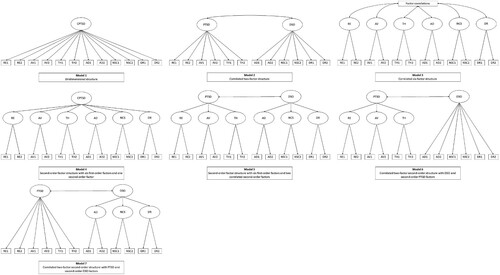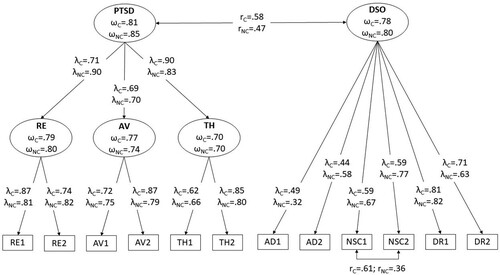Figures & data
Table 1. Comparison of the clinical and non-clinical samples.
Figure 1. Competing measurement models. CPTSD = complex post-traumatic stress disorder; PTSD = post-traumatic stress disorder; DSO = disturbances in self-organization; RE = re-experiencing; AV = avoidance; TH = current sense of threat; AD = affective dysregulation; NSC = negative self-concept; DR = disturbed relationships.

Table 2. Post-traumatic stress disorder (PTSD) and disturbances in self-organization (DSO) symptom and dysfunction scores; and PTSD, DSO, and complex post-traumatic stress disorder (CPTSD) criteria prevalence rates.
Table 3. Model fit of the measurement models.
Figure 2. Factor loadings, correlation estimates, and reliability indices for the modified Model 6. λ = standardized factor loading; r = correlation estimate; ω = model-based internal reliability omega estimate. Estimates with subscript C are presented in the clinical sample, while estimates subscript NC are presented in the non-clinical sample. All estimates are significant at at least the p ≤ .003 level. PTSD = post-traumatic stress disorder; DSO = disturbances in self-organization; RE = re-experiencing; AV = avoidance; TH = current sense of threat; AD = affective dysregulation; NSC = negative self-concept; DR = disturbed relationships.

Table 4. Comparison of the International Trauma Questionnaire (ITQ)-based post-traumatic stress disorder (PTSD), disturbances in self-organization (DSO), and complex post-traumatic stress disorder (CPTSD) diagnostic groups in terms of the total number of personally experienced trauma exposure types.
Table 5. Comparison of groups with increasing levels of types of interpersonal, non-interpersonal, and childhood traumatic experiences in terms of post-traumatic stress disorder (PTSD) and disturbances in self-organization (DSO) standardized factor scores.
